Heading into its fifth weekend at the U.S. box office, Genndy Tartakovsky’s Hotel Transylvania 2 has proven to be a crowd-pleaser in both the United States and abroad, cementing the Drac Pack’s status as a valued franchise for Sony Pictures Animation.
One of the key creative figures on this second trip to Hotel T was production designer Michael Kurinsky. While it’s Kurinsky’s first outing as a feature film production designer, he’s enjoyed a distinguished career in animation, including a decade at Disney painting backgrounds on hand-drawn films such as Hercules, Tarzan, Fantasia/2000, and Atlantis: The Lost Empire. For the last dozen years, he’s been at Sony, where he’s contributed to most of their animated projects, including art directing the splashy universe of Cloudy with a Chance of Meatballs.
As production designer of Hotel Transylvania 2, Kurinsky was responsible for expanding the world while maintaining visual consistency with the original film’s universe. Among the most memorable expansions in the new installment were the introductions of Dracula’s father, Vlad (voiced by Mel Brooks), and his menacing sidekick Bela (Rob Riggle). I spoke with Kurinsky at length about the process of creating these characters, their environment, and how they evolved through the course of the production.
Michael Kurinsky: Vlad originally wasn’t in the first script. We had a completely different villain: it was this real estate mogul named Quinston and they were trying to get Quentin Tarantino to be the voice. Actually the designs looked a lot like Quentin Tarantino. And two things happened. One, Quentin Tarantino turned down that role, and two, it just didn’t work after they did a first screening. You know, you’re in this monster world and your villain is a human real estate developer who wanted to turn the Hotel Transylvania into a theme hotel, kind of like the W. I think it was going to be called the T, and he wanted to put them all over the world.
So, Genndy came up with this idea: What if Dracula had a dad? In the final version of the movie, Mavis does know about Grandpa Vlad because she says it in the wedding sequence, but in the original, she didn’t even know she had a grandfather; he was a recluse. He and Drac were estranged from each other; that was the tone. So we were like, “This is cool. He’s really old school monster.” This union of Mavis and Johnny would be very upsetting for him. And you’d get this backstory that Drac and Vlad had some sort of bad fallout and they haven’t talked to each other for 600 years or something crazy like that.
Vlad was thrown out to two different artists: Craig Kellman and Andre Medina. Andre did some really funny stuff; picture like Danny DeVito being Vlad. This is before we knew who the voice was going to be. So he had these little tiny stumpy looking guys, and then he had these sort of dandified looking guys, almost like Gary Oldman when he was playing Dracula. We had a big range, but when Craig’s stuff came in, we got the most laughs out of those. When Craig heard Mel Brooks was doing the voice, a design came in from him, and we told him we liked that design. The next thing we knew we got a bunch of expression sheets back from Craig and now you could almost hear Mel Brooks’ voice coming out of those drawings.
Genndy is an extremely hands-on director who knows very much what he is looking for. The thing that I think he’s most specific about are the characters. When it comes to a new character design, he’s the one who says, “This is a Craig Kellman design,” or “This is going to be a Stephen DeStefano.” He picked the people he wanted to draw the characters, and sometimes he would even send them a preliminary sketch/idea asking for something in a particular vein.
Where I got mostly involved with characters was when it had to make the translation from black and white drawings into color and texture — either I would paint some of them myself and start really filling out the volume of the character, or I’d hand it to who I thought would be the best artist to do that character.
For Bela, I just took one of Stephen DeStefano’s drawings that I liked, and just wanted to try something out so I started painting this thing. I had a picture in my head for these creatures that clearly never see the light of the day and live in a cave, and what the quality of their skin was going to be, almost a translucent fish-flesh kind of thing. I can be a real renderer and a real noodler if need be, and was really happy with the painting because it got the quality of the skin, and the leathery wings and the veins running through it. I loved monster movies as a kid, and this really had all the things that were in my head.
Genndy could have told me to dial it back but he didn’t. He liked all that stuff. I remember when I put that painting up, he said, “This is scary. You’re going to scare kids. But we should work with these kind of textures, and when we get the right kind of facial expressions on this character, it won’t be that scary.”
And he wanted to go even further than what the painting had, not so much in the textures, but based on looking at the drawing Stephen had done, he asked our vfx supervisor, “Can we build a muscle system underneath the skin?” Because normally it’s skeleton on the inside and you’re animating just the skin that has the volume in it. He said, “I’d like a skin with real muscles underneath it and then the skeleton,” so that we could really feel when these characters bent their arms and made a fist — you could feel the muscles flex and tense. We took the realism in this character much further than any other character in the Hotel Transylvania universe.
Vlad and Bela’s Environment
Michael Kurinsky: When Vlad was written into the script, whenever they would talk about his location, it would say “Exterior: Vlad’s Castle,” so we started designing castles. At 10 o’clock every morning we had these meetings where we would show Genndy what we were working on, and we put up a bunch of castle sketches, and he was like, “We already have a castle. It’s called the Hotel. Let’s do something different. What if we put him into a more natural structure like a cave or something?”
I don’t think Genndy had discussed it with the writers or anything like that. It was just an idea that he had right there in that meeting and we immediately went and attacked it. We started designing this cave, which actually worked great, because Vlad felt like a reclusive hermit in there, like he purposefully was sequestering himself away from his family, from the world, from everything. And it really set the stage for who this character was; it helped support his story.
There was a whole sequence that I absolutely loved and it hurt so bad when I heard it was being taken out for time. There was a sequence called “Meet Vlad,” and it helped strengthen this story of how this person wanted to be left alone. In the sequence, Frank and Drac have to go to Vlad’s lair. To do that, they first had to drive through this windy mountain road and then the car comes to a dead end, and then they had to go down a rocky hill; they had to crawl through a tunnel, and then at the tunnel, there was another steeper hill that was covered in big stickly briar patches, and they kind of bounced down that hill. A trap door would open up and they’d fall down this never-ending hole, and then boom, they landed into an entry chamber where they were greeted by one of the cronies, who escorted them through a little passageway which led into the throne room.
When we were going to do the lighting for it, we started with this really warm lighting at the top of the scene and as they kept moving down, down, closer to Vlad’s lair, the lighting would get colder and colder, so what it was doing was supporting the story of this guy — that he was this cold, angry curmudgeon, and this is where he chose to live. It was the classic example of showing, not telling who this character was. It was all done with visuals and music; there was very little dialogue as they were traversing all this stuff. And you would have felt when we finally got into his presence, “Oh my gosh, I know a lot about this guy already.”
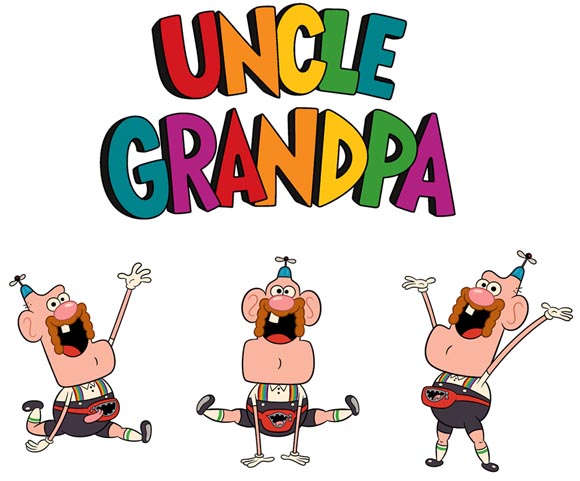
Uncle Grandpa premieres this evening at 8 p.m. (ET, PT) on Cartoon Network. The show was created by Peter Browngardt, 34, who also voices the handlebar-mustachioed star of the show. Uncle Grandpa has been gestating since 2008 when it was part of Cartoon Network’s Cartoonstitute program. The original pilot gained a following online after it was posted on YouTube in 2010, the same year in which the pilot was nominated for an Emmy.
The show revolves around Uncle Grandpa, a fanny pack-adorned, propeller beanie-bedecked gentleman of uncertain origin who travels in a magical RV dispensing ‘Good mornins’ while helping children achieve their dreams. If it sounds like an unconventional setup for a children’s cartoon, the show’s style of humor is even more unique.
Surrealist visual humor, the type of which was practiced by cartooning giants like VIP Partch, Tex Avery, and Don Martin, went out of fashion sometime in the late-Eighties. Uncle Grandpa rejuvenates this strand of comedy with gusto: bodies disassemble and reassemble on command, conceited slices of pizza drive motorbikes, and parallel worlds exist in fanny packs (or belly bags, per the show’s lingo). Browngardt’s new show dispenses with the polite verbal banter of other animated TV series; it is visually vulgar and aesthetically abrasive, and because of its sheer audacity, it’s laugh-out-loud funny.
Cartoon Brew spoke to Browngardt about the show. We accompany the chat with a gallery of production and pre-production artwork from the series.
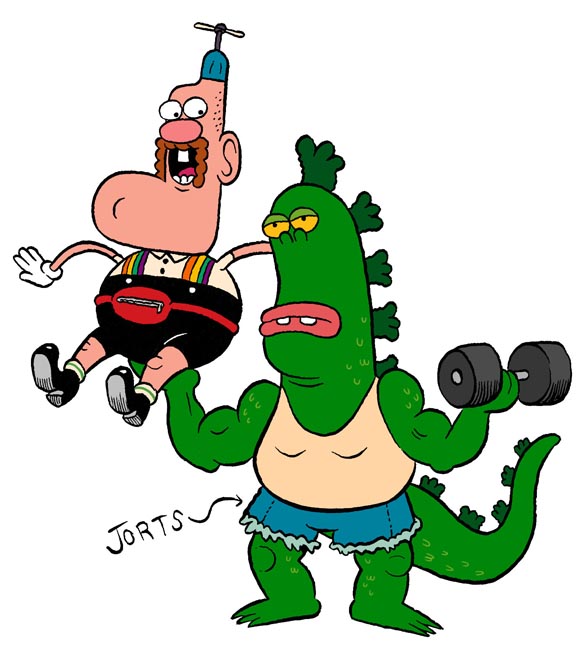
Cartoon Brew: Did you have an Uncle Grandpa-like figure when you were growing up or is it something that you wish you had?
Pete Browngardt: Actually, I think it’s sort of a combination. Growing up, I had uncles, but the funny thing is that neither one of them were actually blood-relatives. They were just my father’s really good friends. I think a lot of people have that, where you just call them Uncle Bob or Uncle Dan or whatever. And these guys were larger-than-life characters. Whenever they came to hang out, it was a nutty time. They let me drive when I was seven years old just to see me drive. We’d build potato cannons and all kinds of stuff that you probably shouldn’t be doing with kids. They were kids at heart as well and they had crazy stories of their life. Like, one of them fought in World War II and hid in a cave, and then got captured and escaped from a POW camp. It was always something adventurous or a good time when they showed up. And then also, I did have a lot of imaginary friends as a kid and I’d go out in the woods and play out scenarios, wishing I could get away.
Cartoon Brew: How many ideas had you pitched before you pitched Uncle Grandpa to Cartoon Network?
Pete Browngardt: It was my first time ever pitching to a studio. A friend, Stephen DeStefano, had a connection to pitch at the studio. I was living in New York at the time. We flew out, and said, ‘Let’s pitch three ideas each.’ I just did quick pitch bible things for three ideas, and pitched to Craig McCracken and Rob Renzetti. Craig and Rob really responded to Uncle Grandpa. And while I was out there, Carl Greenblatt from Chowder had seen my work and he hired me to board on that. I actually moved out to LA to work on that, and through that time period, Cartoonstitute started.

Cartoon Brew: This might be a good moment to talk about your background. I heard you started in animation when you were 19?
Pete Browngardt: I started making animated films when I was seven years old. My older brothers were into making films, they used to make Super 8 horror movies, so I was basically born into a household that liked filmmaking, acting and drawing and all these arts…it was odd to me that other families didn’t do it.
My brothers explained to me at an early age how animation works, and I was like, ‘Wow, you can actually do this.’ My dad and my brother helped me build a lighttable from the back of the Preston Blair animation book, and one of the first things I ever animated was a character swallowing a bee. I animated dog food falling on a dog. I always drew, and I started making animated films all through elementary school. In high school I made stop motion films and some live-action films, and also took a lot of drawing classes.
Got into CalArts and then made films there. After my second year at CalArts, they had that job fair and Producers’ Show, and one of the directors at Futurama saw my second-year film and offered me a job. Basically it was a summer job, and they wanted me to stay, but my parents and myself, I wanted to finish school and get a degree. I ended up going back to school. But yes, when I was 19 I did that. The following summer I got picked for an apprenticeship at Industrial Light and Magic, and I tried doing CG animation which wasn’t a good fit for me. Really missed drawing, but it was a great experience and it was amazing to be in an environment like that. Then, after that I moved back to New York, which is where I’m from, and worked at Augenblick Studios, MTV, World Leaders when they were doing Venture Bros. Then, when I was there, I ended up coming back and pitching to Cartoon Network.
Cartoon Brew: The original Uncle Grandpa pilot was one of the funniest and most original pilots I’d seen. But then you made the series Secret Mountain Fort Awesome, which was based on a gag in the pilot. Was that another one of the pitches? How did it work out that you made a pilot for one thing and got a show for something else.
Pete Browngardt: Well, it was kind of a thing where they weren’t sure about Uncle Grandpa for filling out a whole show. So they asked me to come up with some other things that spun off of it and Secret Mountain was one of those. It was an amazing learning experience for the whole process—of pitching something and then seeing how it can manipulate and change while you’re working on it.
Cartoon Brew: You used a lot of metal and thrash music in Secret Mountain. Can we expect Uncle Grandpa to contain the same?
Pete Browngardt: That music was really for that show. I love that music and when we were doing the animatics for Secret Mountain, I would throw in that music in the temp scores, and it blended really well with the imagery and what I was going for with the design. Now with Uncle Grandpa, there are aspects of that in the music, but we’ve tried to lighten the tone. This new Uncle Grandpa has evolved to be more light-hearted in the sense of a broad kids show, which I’m really excited about. It’s more like Pee-wee’s Playhouse with an expanded cast and expanded world, and I wanted to have more variety in the music and be able to go sort of a happier place, though it does go dark and heavy at times.
We’re actually breaking format on the shows, where within the eleven-minute episodes, we have two stories plus bumpers. We have a seven-to-eight minute story and a two-to-three minute story. Ren and Stimpy used to do that, and even Dexter’s Lab did it, and I really love it because we’re able to experiment. One of the shorts we’re doing is “Uncle Grandpa Sings the Classics,” and it’s Uncle Grandpa singing all the different genres of music. One of them is black metal, and it’s amazing. I was, like, they’re never going to let us put black metal into a kids’ cartoon, but they did.
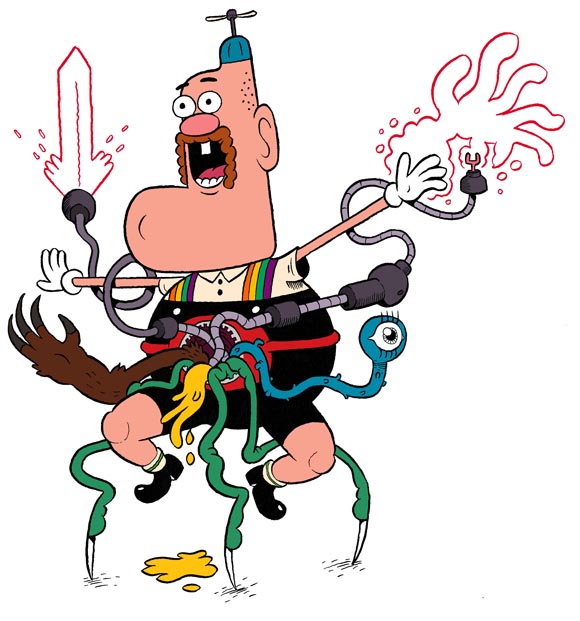
Cartoon Brew: This is one of the few shows Cartoon Network has ever done, if not the only one, where the lead character is over the age of thirty. Usually, the stars of their shows are either kids or teens or in early-20s, but here you’ve got some older dude. I’m curious, within the studio, was that ever a point of contention or awareness that the show was different from everything else they’re doing?
He’s a magical guy who shows up and takes kids on adventures, so we always say he’s like Santa Claus with a GED.
Pete Browngardt: It definitely was talked about. The way I approached writing him, and we all do on the show, is that he may look like an old man but he’s basically a man-child. Once you see what he does, how he acts and talks, you’ll be like, ‘Oh he’s kind of a child.’ It never was a major concern. The [network would] want to veer us towards writing him like a kid because it is a kids’ cartoon and that’s what I wanted to do the whole time so it never was in contention.
Cartoon Brew: It’s funny that you say man-child because I looked at some of the YouTube comments and the most common adjective use d to describe him is ‘retarded.’ That’s not what he is, but that’s kind of another way of saying man-child.
Pete Browngardt: He’s a magical guy who shows up and takes kids on adventures, so we always say he’s like Santa Claus with a GED. And also, there’s this running theme that when he helps kids and stuff, we tell the story in a way where at the end, you don’t know if he’s an idiot or a genius. And I think that busts that whole thinking that he’s just an idiot because you’re wondering, ‘Did he have all this figured out from the beginning or is it all by chance?’
Uncle Grandpa Art Gallery






Cartoon Brew: I want to talk a little bit about the visual style of the show. I read MAD when I was a kid, and I see a lot of Don Martin influence in the show. Was that an influence at all, and what are your other visual influences?
Pete Browngardt: Definitely MAD magazine. I had older brothers and they had Seventies and early-Eighties MAD magazines around the house. I used to draw from them constantly when I was a kid. At a certain age, my mom was like, ‘I don’t know if you should be looking at these things,’ so I’d sneak in and check them out. But definitely MAD magazine overall, and Don Martin, and then I got into [Harvey] Kurtzman later when I discovered who he was and how he’s the genius behind the whole thing.
Loved Gary Larson’s Far Side as a kid. Really big influence. I had certain breakthroughs as an artist when I was a kid. Like, MAD was one of them. And then in junior high, the Crumb documentary came out. I’d never heard of R. Crumb and when I saw that and got into his work, he was a huge influence. Garbage Pail Kids was huge with me too, John Pound and all those guys. And then, I got exposed to Tex Avery at a really early age. I had a Screwball Classics VHS that I memorized every cartoon on, and old Warner Bros. too. I would say it’s a blending of all of that stuff. I’m also influenced by contemporaries around me, other artists like Pen [Ward] and Aaron Springer, Carl Greenblatt, lot of people. We all sort of feed off each other.
Cartoon Brew: It’s funny because we have a very similar set of influences because we’re so close in age. When I see your show,, I can understand a lot more where the influences are coming from as opposed to a show created by someone who’s in their mid-to-late 20s. That person will have a completely different set of influences that they’re using, not better or worse, but different.
Pete Browngardt: Absolutely. When I see some of the other creators at the studio and just in animation in general, I’m like, wow. It might not be that huge of a span of years, but it is what you grew up on. I don’t even know if I realized it at the time, but a lot of our crew were all around the same age, and it’s funny because it’s like a second language. You go, ‘Make that look like this or that,’ and everybody knows because we’re all around the same age. We do have some young people starting out, and some people that might be a little older, but especially around the board artists and writers, we’re all around the same age. We all watched the same stuff and we’re influenced by pop culture the same way.
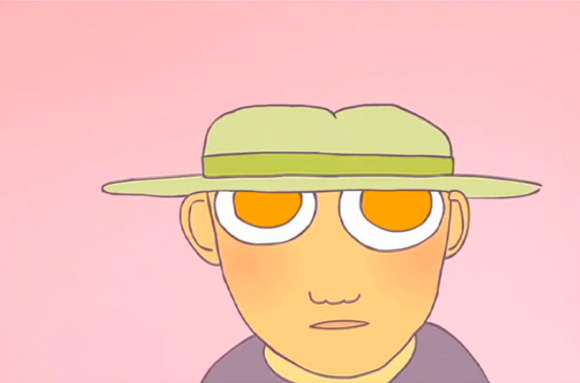
Stefan Gruber is an artist, animator, musician and teacher. He founded and teaches in the animation department of the alternative high school, Nova, in Seattle.
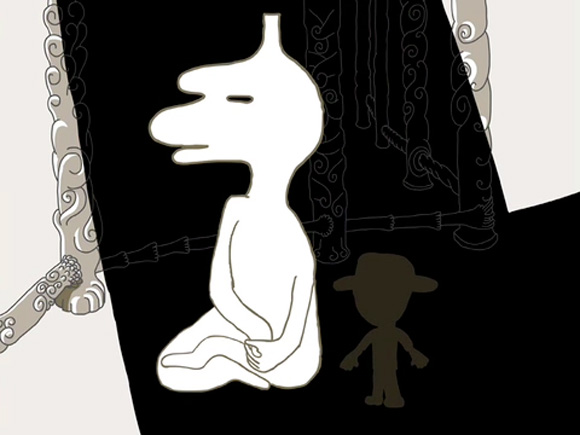
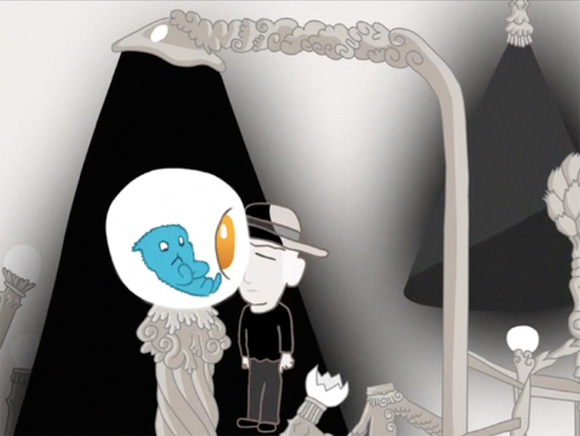
Stefan’s work is personal, often experimental, and always worth experiencing for its original perspective.
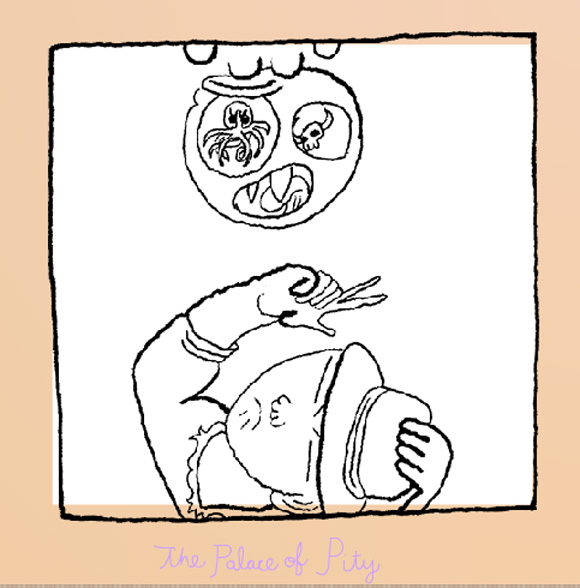
One of his long-standing platforms for broadcasting his various work is the Fantasy Pleasure Complex, which may be best described as an online, multimedia zine. Ten issues have been published, and each is designed as an interactive Flash screen that is a unique work itself and allows access to other videos, comics and experimental pieces.
Fantasy Pleasure Complex was strange and exciting to experience at its debut in 2000, and still stands as a strong, independent presence that is like nothing else online in 2013. Find the vertical column of numbers in the lower left of FPC10 to navigate backwards to earlier editions.
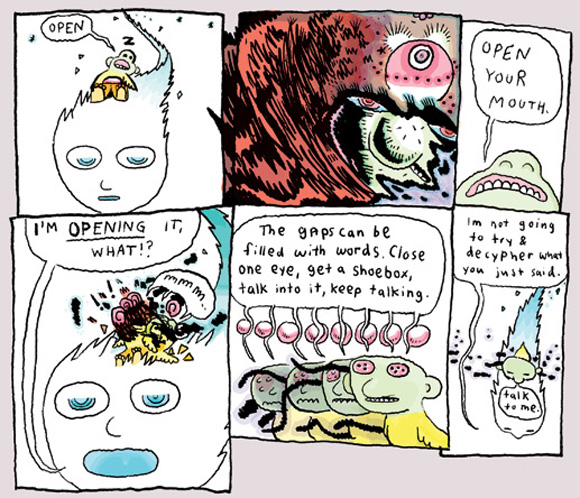
A small sampling of his animation is available his YouTube account, such as “Six Mystic Flipbooks; Magic Gems of Animation”:
A short documentary from producer Patricia O’Brien and director Paige Barnes on Stefan is here is a good introduction to him and his work:
Another more recent short about Stefan from Ben Taylor and Brittany Alsot is here:
Disney unveiled a new Mickey Mouse short today called Croissant de Triomphe, that can be watched HERE. It is one of 19 new shorts that will begin airing on Friday, June 28, on the Disney Channel, Disney.com and other Disney-branded platforms.
Paul Rudish (Dexter’s Laboratory, Sym-Bionic Titan, My Little Pony: Friendship Is Magic) is exec producing and directing. Aaron Springer (SpongeBob SquarePants, Korgoth of Barbaria) and Clay Morrow (Dexter’s Laboratory, Chowder, Camp Lazlo!) are also directors. Joseph Holt is art director and Stephen DeStefano did character design.
If the first short released Croissant de Triomphe is any indication, this is a handsome and distinctive series, featuring a mixture of Cartoon Modern-styled backgrounds and loose, expressive cartoon animation. The three-and-a-half-minute running time of the first short is perfect. I’m glad that studios are awakening to the fact that there can be other lengths besides 7- and 11-minute episodes.
If I have any observation about the first short Croissant de Triomphe, it’s that it struggles to find the humor in its set-up, which is Mickey driving around Paris on a scooter. Outside of a couple half-hearted attempts at gags (nuns knocked into the air like bowling pins who then float down, an appearance by Cinderella), the cartoon emphasizes frenzied non-descript action sequences over slapstick. Even obvious gag set-ups—for example, Mickey dressed as a knight and lancing croissants—have no comedic payoff. Hopefully as the crew finds its footing, they are able to balance the accomplished action sequences with a more spirited comic sensibility.

















